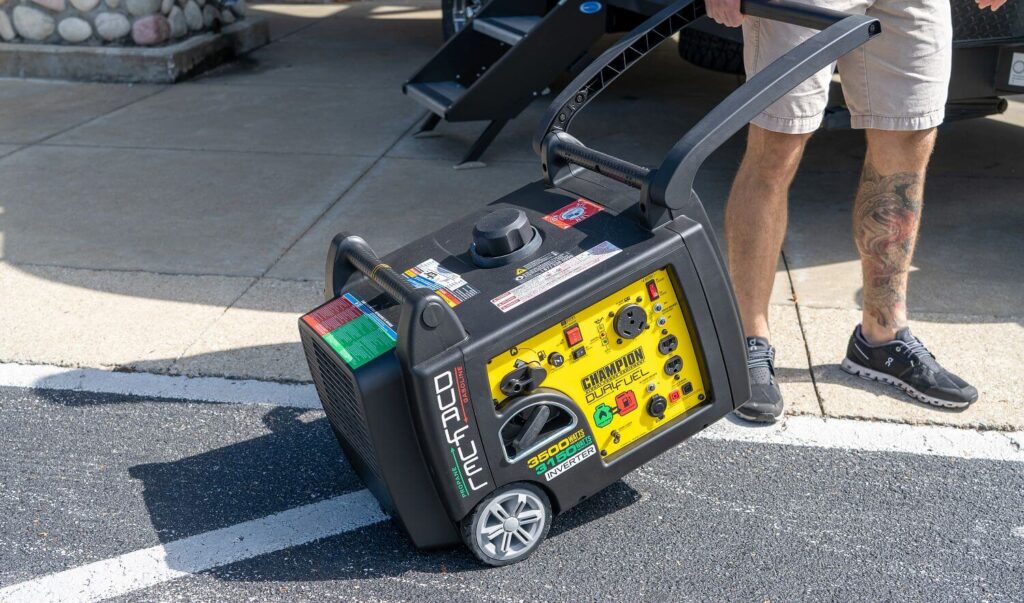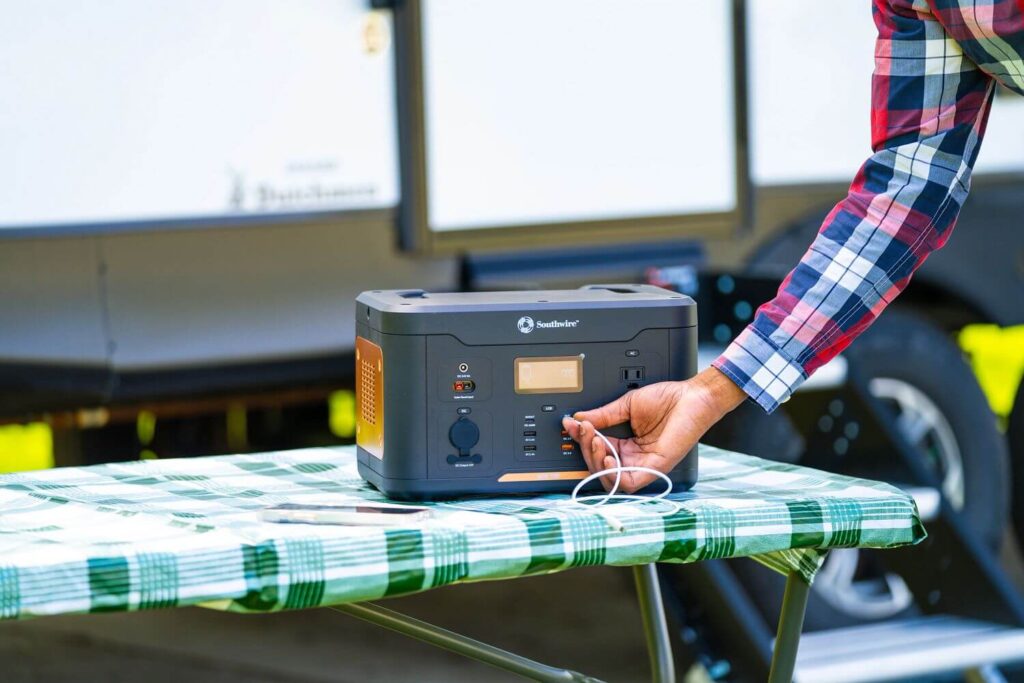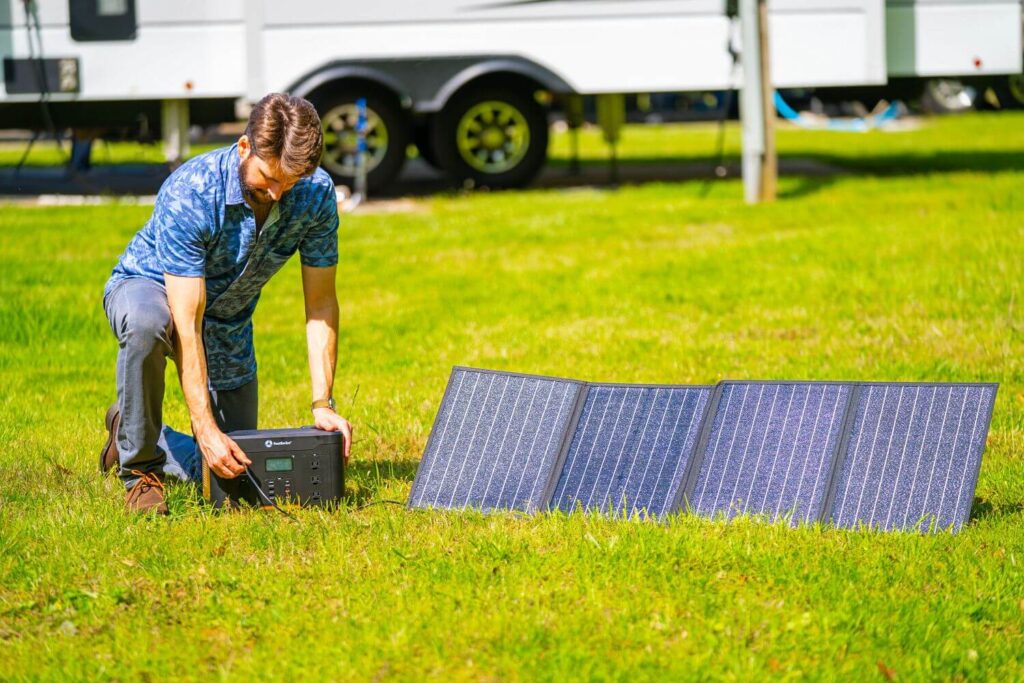Do you camp off-grid or frequently tailgate at sporting events, festivals, or concerts? Maybe you need emergency backup power? Have you ever blown an RV fuse because you’ve plugged in too many appliances at once? If you answered “yes” to any of these questions, a portable power station may be a helpful addition to your tool kit.
If you’ve been considering purchasing a portable power station but have found yourself confused by all the technical specs and jargon, we’re here to help. We have some suggestions on what to look out for when choosing a model and tips on how to get the most out of these eco-friendly power sources.
Key Takeaways
- Portable Power Stations vs Generators: Portable power stations provide quiet, eco-friendly energy storage without relying on fuel, making them ideal for off-grid camping, tailgating, and emergency backup power. Unlike gas generators, they require little maintenance and can be recharged via wall outlets, carports, or solar panels.
- Key Features & Considerations: When choosing a portable power station, consider battery capacity (measured in watt-hours), power output (watts), charging options, and weight/size balance. Most modern models use lithium-iron phosphate (LiFePO4) batteries for longer life and efficiency.
- Top Brands & Models: Leading brands like EcoFlow, Jackery, Southwire, and LION Energy offer a range of power stations for various needs, from compact units for charging small devices to high-capacity models that can power RVs or homes.
Table of Contents
ToggleWhat Is a Portable Power Station?
A portable power station is a rechargeable battery pack that stores power for use when a traditional energy source, like an electric RV hookup, isn’t available.
Equipped with an array of power ports, these battery packs can supply enough energy to recharge electronic devices, run appliances, or even power an entire home.
Portable Power Stations vs Gas Generators

Unlike a traditional gas-powered generator, a power station doesn’t generate a lot of noise or harmful emissions.
With portable power stations, you aren’t reliant on fuels such as gasoline or diesel gas, to create power. Power stations have little to no upkeep, unlike a generator which requires regular generator maintenance and cleaning.
One major advantage of portable power stations is that most can recharge using a solar panel. In theory, this means they can provide unlimited power, even when living entirely off the grid.
However, solar energy can be slow and unreliable at times. Because of this, many users only charge their units by plugging them into a standard 120V AC wall outlet at home. Most power stations can also charge using the 12V DC port in a car, truck, or RV.
What Are Portable Power Stations Good For?

Portable power stations have several uses, including serving as an emergency backup power supply during a blackout. Here are a few more. Can you think of more? Tell us in the comments below.
- At construction sites providing energy for power tools.
- At campsites for backup power, or as main sources of power for off-grid camping.
- At tailgating events, for powering lights, TVs, fans, or e-bikes.
- At art festivals or outdoor shows for powering electronic devices and fans.
- At home in the event of a temporary blackout due to severe storms.
Depending on their size, portable power stations can provide enough electricity to run electronic devices, appliances, and power tools.
Why Buy a Portable Power Station Now?
When the first portable power stations arrived on the market more than a decade ago, there were only a handful of options. Today, things are much different, as there are now dozens of models for almost any energy need.
Increased competition in the power station market has been good for consumers, driving down prices and pushing battery and charging RV technology forward. But it has also made buying one of these devices more complicated, as it can sometimes be challenging to distinguish the advantages of one model from another.
Some power stations are small enough to carry, while others are so big that they come with built-in wheels to help move them around. The higher the energy capacity of the device’s batteries, the larger and heavier it will be. Most weigh approximately 25-35 pounds, although there are plenty of smaller and larger models to choose from.
Choosing a Portable Power Station
Picking the right power station for your adventures depends on several variables.
- How long do you intend to stay off the grid?
- What kind of devices and appliances do you want to plug into it?
Smaller power stations tend to be lighter and more portable but have less battery capacity. On the other hand, larger units increase performance but get heavier and more ponderous in the process.
Finding the right balance to meet your needs is essential. Here’s how to choose the right power station for you.
Understanding Battery Capacity

One of the most important specs for any portable power station is how much energy it can store in its battery packs. This is measured in watt-hours (Wh), which represents how long it can operate while supplying one watt of power for an hour. As you would expect, the higher the number, the better.
For example, a power station with a capacity of 2000Wh can run for up to 2000 hours, provided it supplies only one watt of electricity. However, electronic devices and appliances require much more energy than that, so they deplete the battery at a faster rate. For example, a typical smartphone uses just 5 watts of juice to charge, while a refrigerator requires between 100 and 250 watts to operate.
Understanding the power requirements of the gadgets and appliances you use will help you determine the capacity you need from a power station. Just remember that those needs can change over time, so it may be a good idea to purchase a power station that provides more capacity than you currently need so you have some room to grow.
Type of Battery
In addition to battery capacity, you’ll also want to pay attention to the type of battery used in the power station. In the past, lead-acid power cells were common throughout the industry, but in recent years, they have been phased out in favor of lithium-ion batteries. This style of battery is more energy efficient, can store more power, and is lighter and safer, too.
Most new power stations now use lithium-iron phosphate (LiFePO4) batteries. This type of power cell is lightweight, offers excellent energy storage, and has a much longer lifespan. With a LiFePO4 battery, users can expect their power station to continue functioning properly through 3000+ recharge cycles, a substantial upgrade over previous generation devices, which often had issues after being recharged just 500 times.
Some power station manufacturers also offer replaceable batteries. This allows the user to replace a worn-out power cell with a new one without purchasing an entirely new device. It also makes it easier to recycle the depleted battery in an effort to lessen the impact on the environment.
Power Output

A power station’s output is measured in watts, which indicates how much electricity it can supply to the things that are plugged into it. The higher the wattage, the more devices and appliances it can power simultaneously. Higher wattages also allow the power station to handle more energy-hungry appliances like an air conditioner, a space heater, or an electric grill.
When reading the specs for a power station, you’ll often see the “peak” output listed. This is the maximum amount of power—in watts—that the unit can put out for a short period of time to accommodate a brief spike in power.
For example, a portable air conditioner may require 3000 watts to run but could potentially require as much as 4500 watts when first turned on. A power station needs to offer enough sustained output (3000W) to keep the AC unit running but must also have the capacity to hit the peak energy requirement (4500W) when the unit is first activated.
Once again, understanding the power requirements of the devices you intend to use with the power station will help you make a more informed purchasing decision. Most electronic devices—like smartphones, tablets, and laptops—won’t have much of an impact on a power station’s performance at all. On the other hand, power-intensive appliances will drain the battery very quickly if the power bank isn’t equipped to handle the demand.
Charging Ports

Most power stations come with a similar selection of charging ports, although they vary greatly in the number of outlets provided. The most common options include 120V AC wall outlets like those found in our homes, a 12V DC vehicle charging port, and a mix of USB-A and USB-C ports. Some units also include 12V DC5521 “barrel-style” ports or an Anderson power pole, although those are used less frequently by consumers. An increasing number of power stations also now include a wireless charging pad for use with smartphones and other gadgets that support that type of charging.
When selecting a power station, think about the devices you’ll be plugging into it.
USB ports are perfect for charging mobile devices, laptops, and other small gadgets, while 120V AC wall outlets are handy when using appliances, TVs, or air conditioners. Look for a power bank that allows you to plug in everything you need, with a few extra ports for those occasions when you require additional capacity.
Recharging Options

There are three methods for recharging the vast majority of power stations on the market.
- You can plug them into a 120V AC wall outlet at home
- You can use the 12V DC port in a vehicle
- You can connect them to solar panels to harvest energy from the sun.
The fastest and most reliable method is a home wall outlet, while the slowest is usually the DC port in your car, which can often take more than twice as long to top off the battery.
One of the most significant advances in power station technology in recent years is the addition of quick-charging capabilities. In the past, it could take 5-6 hours or even longer to recharge the batteries using an AC wall outlet. But newer models can replenish the power cells in less than half that time.
When shopping, check the specs for charging times to get a sense of how well it will perform. A device that supports faster charging speeds means you’ll spend less time waiting for it to be ready and more time enjoying your destination.
If you intend to charge your power station using the sun, you’ll want a model that supports a higher input wattage from a solar panel.
Manufacturers usually list how many watts of power a power station can accept using this charging method. A power station that can handle 400W versus 200W can theoretically charge twice as fast, provided you have the proper number and type of solar panels. Environmental variables can impact solar charging efficiency, like cloud cover, shadows, and the movement of the sun. If you’re not pressed for time, and in a sunny location, it is a viable way to keep the device charged.
Size and Weight

A small, lightweight power station is easy to travel with but stores less energy and powers fewer gadgets than a bigger model. If portability is of the utmost importance, you may have to sacrifice performance in favor of size. If you aren’t as concerned about having a model that is easy to move around, you can invest in a larger and more capable power station.
In addition to bigger batteries and more power output, larger units also tend to have more charging ports. That could be important if you plan to plug a lot of things into the device at the same time. Once again, it is all about finding the balance between portability and usability based on your specific needs.
Other Features
Other features may or may not be important to your purchasing decision. For instance, many portable power stations allow users to monitor performance and adjust settings remotely using a smartphone app. If that would be useful for your needs, then you’ll want to look for a device that offers that capability.
Similarly, nearly every power station comes with a built-in LCD screen for monitoring power input and output, battery charge levels, charging speeds, and so on. Some of those displays are bright, vibrant, and very easy to read, while others offer minimal information on a dim, monochrome interface. How important is the quality of the LCD screen to you?
Other common features for power stations include built-in LED lights, fast-charging components, expandable battery capacities, and wireless charging pads.
Some units support connections to your home to serve as backup power during a blackout, while others can be used as an uninterruptible power supply for essential devices. Some models are rugged and built for the outdoors, while others have a more elegant design that favors form over function. How important those features are to you could impact the unit that you ultimately end up buying.
Price

Power stations can range in price from as little as $300 to as much as $6000 or more. Ultimately, the device that you purchase needs to fit into your RV budget while still managing to meet your specific needs. Thankfully, there are so many options to choose from these days that it is easier than ever to find a power station that is both affordable and powerful.
These are the most important things to consider when purchasing a portable power station. Camping World offers an excellent selection online and in retail stores nationwide.
Portable Power Stations We Love
Power stations come in various sizes, offering different levels of performance at affordable prices. Here are our picks for the best portable power station brands:
EcoFlow Portable Power Stations

EcoFlow makes some of the best power stations on the market, ranging from options that are small enough to go anywhere to models that can power your entire house.
- EcoFlow DELTA Mini: With an 882Wh battery and 1400W output, this model can power 90% of household appliances, while remaining highly portable.
- EcoFlow DELTA Max 2000: Big and powerful, Delta Max 2000 has a large 2000Wh battery that can be expanded to 6000Wh as needed. This power station can run devices requiring up to 3400W of electricity, making it a great option for homes or RVs.
- EcoFlow RIVER 2 Max w/ Solar Panel: At just 13.2 pounds, this lightweight power bank offers a 512Wh battery capacity with a 1000W maximum AC surge output. It also comes with a 160W foldable solar panel for easy recharging.
- EcoFlow DELTA Pro: Ideal for larger RVs with higher demand, this power station has a 10800Wh battery capacity and can deliver a standard 3600W AC output. However, with X-Boost technology, that output can be boosted to 4500W.
- EcoFlow RIVER 2 Pro w/Solar Panel: The RIVER 2 Pro offers a 768W battery capacity and an 800W maximum output. With a LiFePO4 battery that can be fully recharged in roughly 70 minutes, it’s a durable, powerful battery bank that also comes with a 220W solar panel that captures up to 25% more energy than competitors.
Southwire Portable Power Stations

Southwire’s power stations are characterized by durable construction and outstanding performance. They are built for use at the campsite, job site, and home, making them highly versatile options for on-the-go charging. Best of all, they have price tags well below most of the competition, putting them in a class of their own.
- Southwire Elite 200 Series: With a 222Wh battery capacity and the ability to charge nine devices at once, this lightweight power station performs well above expectations. It can even go from a completely depleted battery to a full charge in about 1.7 hours.
- Southwire Elite 500 Series: Southwire’s winning formula continues with the Elite 500, a 515Wh power station that adds capacity and increased power outputs over the previous two models. This power bank can charge up to ten devices at once and comes with a bright built-in LED light.
- Southwire Elite 1100 Series: Southwire’s largest and most powerful charging solution, this device has a 1166Wh battery and enough ports to power 12 different devices. Despite its higher capacity, it fully recharges in under five hours using a 120V AC outlet, 12V DC vehicle charger, or a solar panel.
Jackery Portable Power Stations

Jackery has been a leader in the portable power station market for more than a decade. It delivers a wide variety of innovative products and sells a number of different models to meet the needs of nearly all customers.
- Jackery Explorer 550: The Explorer 550 offers buyers a 550Wh battery with a sustained output of 500 watts. It also includes an expanded array of charging ports, making it a great addition to any campsite.
- Jackery Explorer 1500: RVers looking for the ultimate performance will find the Explorer 1500 a great choice. This fast-charging model has a battery capacity of 1534Wh and a sustained output of 1800W, peaking at 3600W.
LION Energy Portable Power Stations

LION Energy portable power banks are designed to provide safe, quiet, and sustainable energy for RV appliances and sensitive electronics. Whether you need an emergency power source or additional charging capability when boondocking, they offer some great options.
- LION Energy Safari ME: This portable power bank has a 922WH battery capacity and a maximum AC output of 4000 surge watts (2000W continuous). It can be recharged using up to six compatible solar panels, offers multiple charging ports (USB, AC, and 12V), and is rated for more than 2,500 life cycles.
- LION Energy Safari ME Expansion Pack: The expansion pack is compatible with the Safari ME and adds 2048Wh of battery capacity with a two-year charge retention. Like the power station itself, it’s rated for a long lifespan at more than 3,500 life cycles.
Keeping your RV and your personal electronics charged can sometimes be a matter of safety, rather than just convenience. Explore these additional resources to help you keep your RV fully operational with or without campground hookups:
What questions do you have about portable power stations? Leave them in the comments below.
Author
-

Kraig Becker is a writer and editor in the outdoor, RV, and adventure travel space. He has written for numerous print and digital outlets including Popular Mechanics, Outside, Business Insider, Digital Trends, and countless others. He enjoys hiking, cycling, mountain biking, running, and just about anything else that gets him outside.
View all posts









What can you recommend best power bank for gadgets on our RV?
We have a 2022 Keystone Springdale we boondocks with and used a generator. While not to loud we would like a quieter option. What power bank would you recommend to run fridge, lights, charge devices and the biggest challenge run Starlink. Thanks
Hey Ryan. I’d recommend something like the Jackery 2000 Plus. It offers lots of power storage (2kWh), excellent output (up to 6000W), and it has lots of ports. It is also expandable with add-on battery packs in case you need more capacity in the future. You can find it here: https://www.jackery.com/products/explorer-2000-plus-portable-power-station
Hi Roland,
It very much depends on how many gadgets, what types, how long your RV trips are, and several other factors.
Did you enjoy any of the power stations recommended in this article?
Here are a few specific reviews if you’re interested in reading further:
https://www.rv.com/gear-accessories/camping-gear-reviews/jackery-explorer-2000-plus-review-faster-safer-and-more-versatile/
https://www.rv.com/gear-accessories/camping-gear-reviews/ugreen-powerroam-1200-review-excellent-performance-and-value/
https://www.rv.com/gear-accessories/camping-gear-reviews/gear-review-lion-energy-summit-power-station/
What size unit should I pick if I would like to use a blow dryer and hair straightener?
Most hair dryers require about 1500 watts of power, although some have a higher energy drain. You’ll want a power station that has at least a 1500W output, but I’d recommend something with 2000W to be on the safe side. A hair straightener only requires a draw of about 200W, so just about any unit will do.
I have portable 12 volt freezer that uses 80 watts. How big of a portable power unit do I need to run the unit over night while boon docking unit the sun comes up? This would be the only item that would be plugged in to it.
Hey Gary! If you have a device that draws 80 watts, you’ll need a portable power station that can has enough watt hours to run it for the time needed. For example, if you want to keep your portable freezer going for ten hours, you’ll need a model that offers a minimum of 800 watt-hours. For 12 hours, you’ll need 960 watt-hours, and so on. I’d always recommend having a little extra power to spare for those “just in case” moments. For your needs, the Southwire Elite 1100 (1166Wh) should work fine, as would the Jackery Explorer 1000, both of which are available at Camping World.
Thanks.
What size unit is needed to fully run wan RV with a 30 amp 120 volt plug, using A/C?
Hi Noah,
To fully run an RV you’ll need a sizeable power station for sure. Something like the Jackery Explorer 3000 Pro will work with smaller vehicles, but for something bigger, I’d recommend an EcoFLow Delta Pro or a Zendure SuperBase V. Those models can actually power an entire home and have the ability to add external battery packs to expand capacity. The downside is, they are large, heavy, and expensive, but they can power an RV.